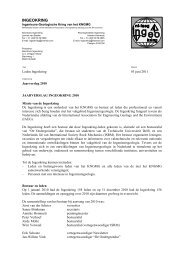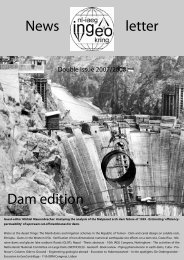environment
environment
environment
- No tags were found...
You also want an ePaper? Increase the reach of your titles
YUMPU automatically turns print PDFs into web optimized ePapers that Google loves.
Ingeokring Newsletter<br />
are available to do so. Repairing a leak in a traditional<br />
way however is expensive and sometimes even<br />
impossible because the locations of leaks are hardly<br />
accessible for big and heavy equipment. The available<br />
methods to repair the leak in situ so far (for example<br />
injection of grouts and gels) have numerous<br />
disadvantages. They are often expensive and<br />
<strong>environment</strong>ally unfriendly. Another disadvantage is<br />
that an excessive amount of injection fluids is required<br />
because the location of the leak is not exactly known.<br />
Therefore, a need exists for easier, more effective and<br />
less expensive methods.<br />
2. BioSealing: a new promising solution<br />
The method of BioSealing utilises the natural chemical,<br />
physical and biological properties of the soil, the<br />
groundwater and the leak itself. The idea of BioSealing<br />
evolved from problems occurring in the field of drinking<br />
water supply, namely clogging in groundwater extraction<br />
wells. In groundwater extraction more or less the<br />
opposite of the problem of leak occurs: near<br />
groundwater extraction wells clogging takes place which<br />
puts limits on the possible amounts of extraction and<br />
causes many problems. These clogging processes are<br />
caused by natural processes in the underground. The<br />
idea of BioSealing was to use and stimulate these natural<br />
clogging processes to repair leaks in water barriers by<br />
adding nutrition. In the case of BioSealing repair of leaks<br />
is interpreted as “to reduce the permeability at the<br />
location of the leak”. One of the goals set when this<br />
method was designed was to reduce the permeability<br />
with at least a factor 5.<br />
Due to a difference in hydraulic heads inside and outside<br />
the water retaining barrier a groundwater flow is induced<br />
towards and through the leak. Addition of nutrition for<br />
micro-organisms near the leak creates a favourable<br />
<strong>environment</strong> which leads to a multiplication of microorganisms<br />
in the vicinity of the leak. The microorganisms<br />
will cause a biological clogging of biomass<br />
in the leak. Later this clogging can be reinforced by a<br />
(biologically induced) chemical precipitation of iron sulphide.<br />
The method of Bio Sealing has been patented by<br />
GeoDelft.<br />
3. Laboratory testing<br />
Set up<br />
In a first stage the BioSealing process was tested in a<br />
laboratory setting. The objective of the laboratory test<br />
was to discover if it was possible to control the clogging<br />
process in a defined <strong>environment</strong> In large PVC columns<br />
filled with natural Dutch Pleistocene sand a separation<br />
plate with small hole was placed, representing a leak,<br />
while water was squeezed through the columns under<br />
constant pressure. The nutrition (Nutrolase provided<br />
by AVEBE) was added to the water to stimulate bacterial<br />
growth and thereby close the leak. The location of the<br />
clogging process and the durability of the clog were<br />
studied.<br />
The experiments were performed under anaerobic<br />
conditions using the water as transport medium for<br />
nutrition. The water flow was directed towards and<br />
through the leak. The water flow was driven by natural<br />
decline in the column (using a storage tank) and the<br />
flow was upwards to prevent specific flow channels to<br />
occur. Two inlets were created, one for water and one<br />
for the nutrition (Nutrolase) was created. Groundwater<br />
velocities used were based on travel time between<br />
injection and hole in real conditions. This time was<br />
estimated for building pits using customary<br />
groundwater conditions, knowledge of leaking<br />
conditions and the knowledge that new leak detection<br />
techniques can find the leak within 5 meters accuracy.<br />
This accuracy is realistic with electrical leak detection<br />
techniques such as ECR and EFT, recently tested on<br />
several sites in the Netherlands and Germany.<br />
Results<br />
From these experiments it was concluded that it is<br />
possible to repair a leak with natural clogging processes.<br />
In the laboratory experiments the clogging always<br />
appeared around the leak, independently of the flow<br />
speed, the size of the leak and the kind of nutrition. The<br />
experiments showed some difficulties. An example of a<br />
difficulty encountered was the formation of gas that<br />
causes temporary clogging. After the gas has<br />
disappeared the leak flow is reinstalled. The gas<br />
formation may be caused by high temperature in<br />
laboratory circumstances. The durability tests showed<br />
that after stopping the nutrition supply the microorganisms<br />
stayed at the hole for the duration of the<br />
test, which was in this case 4 months. This leads to the<br />
conclusion that Bio Sealing is a durable solution. A<br />
boundary condition is that the clogging process takes<br />
place in an anaerobic <strong>environment</strong>, because otherwise<br />
the iron sulphide will oxidate and dissolve.<br />
Figure 2: Set up of the field experiment<br />
10




